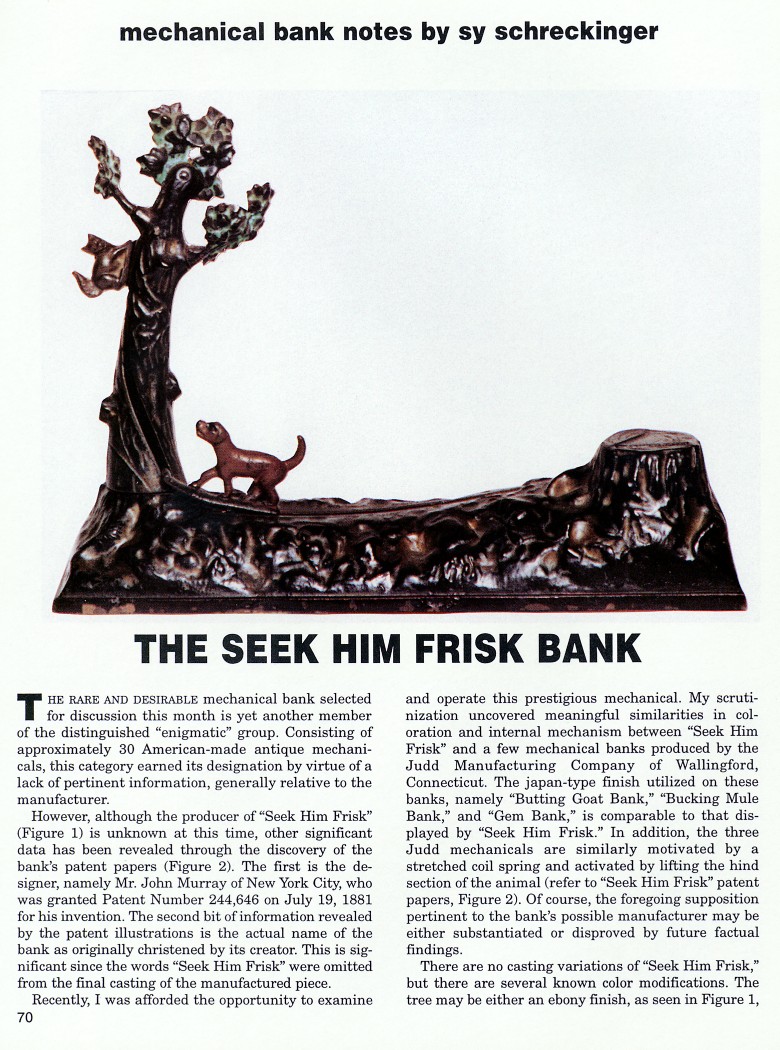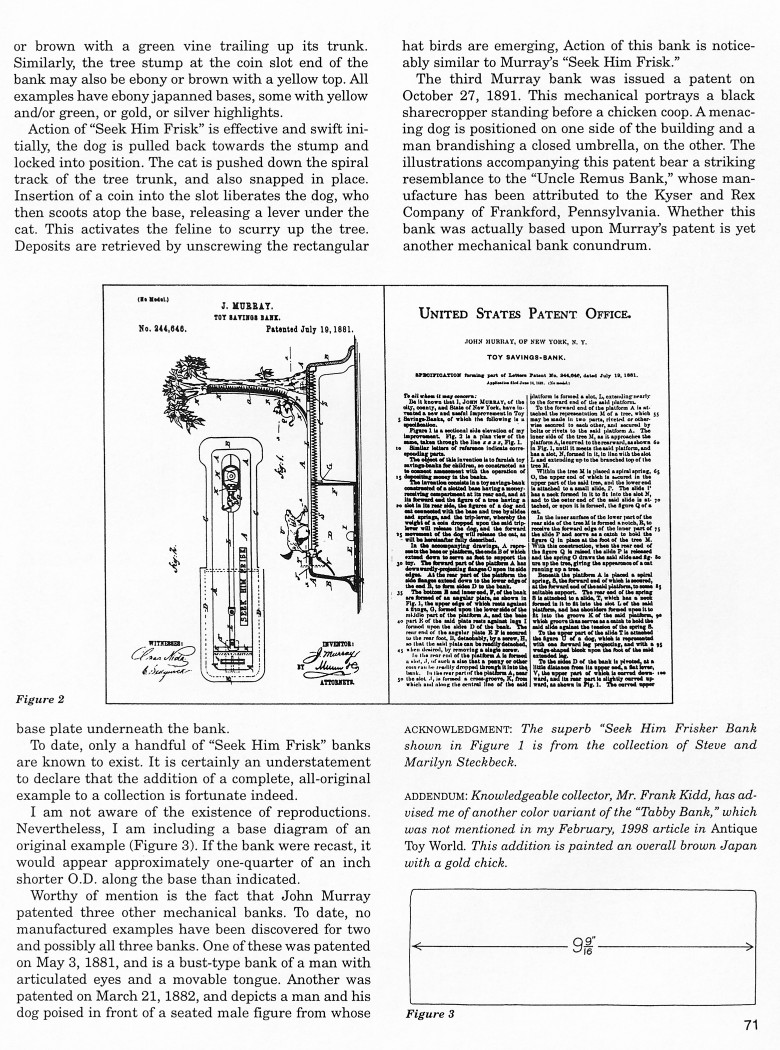|
The Seek Him Frisk Bank
by Sy Schreckinger – ANTIQUE TOY WORLD Magazine – May, 1998
The rare and desirable mechanical bank selected
for discussion this month is yet another member of the distinguished
"enigmatic" group. Consisting of approximately 30 American-made antique
mechanicals, this category earned its designation by virtue of a lack of
pertinent information, generally relative to the manufacturer.
However, although the producer of "Seek Him Frisk" (Figure 1) is unknown
at this time, other significant data has been revealed through the
discovery of the bank's patent papers (Figure 2). The first is the
designer, namely Mr. John Murray of New York City, who was granted Patent
Number
244,646 on July 19, 1881 for his invention. The second bit of
information revealed by the patent illustrations is the actual name of the
bank as originally christened by its creator. This is significant since
the words "Seek Him Frisk" were omitted from the final casting of the
manufactured piece.
Recently, I was afforded the opportunity to examine and operate this
prestigious mechanical. My securitization uncovered meaningful
similarities in coloration and internal mechanism between "Seek Him Frisk"
and a few mechanical banks produced by the Judd Manufacturing Company of
Wallingford, Connecticut. The japan-type finish utilized on these banks,
namely "Butting Goat Bank," "Bucking Mule Bank," and "Gem Bank," is
comparable to that displayed by "Seek Him Frisk." In addition, the three
Judd mechanicals are similarly motivated by a stretched coil spring and
activated by lifting the hind section of the animal (refer to "Seek Him
Frisk" patent papers, Figure 2). Of course, the foregoing supposition
pertinent to the bank's possible manufacturer may be either substantiated
or disproved by future factual findings.
There are no casting variations of "Seek Him Frisk," but there are
several known color modifications. The tree may be either an ebony finish,
as seen in Figure 1, or brown with a green vine trailing up its trunk.
Similarly, the tree stump at the coin slot end of the bank may also be
ebony or brown with a yellow top. All examples have ebony japanned bases,
some with yellow and/or green, or gold, or silver highlights.
Action of "Seek Him Frisk" is effective and swift initially, the dog
is pulled back towards the stump and locked into position. The cat is
pushed down the spiral track of the tree trunk, and also snapped in place.
Insertion of a coin into the slot liberates the dog, who then scoots atop
the base, releasing a lever under the cat. This activates the feline to
scurry up the tree. Deposits are retrieved by unscrewing the rectangular
base plate underneath the bank.
To date, only a handful of "Seek Him Frisk" banks are known to exist.
It is certainly an understatement to declare that the addition of a
complete, all-original example to a collection is fortunate indeed.
I am not aware of the existence of reproductions. Nevertheless, I am
including a base diagram of an original example (Figure 3). If the bank
were recast, it would appear approximately one-quarter of an inch shorter
O.D. along the base than indicated.
Worthy of mention is the fact that John Murray patented three other
mechanical banks. To date, no manufactured examples have been discovered
for two and possibly all three banks. One of these was patented on
May 3,
1881, and is a bust-type bank of a man with articulated eyes and a movable
tongue. Another was patented on
March 21, 1882, and depicts a man and his
dog poised in front of a seated male figure from whose hat birds are
emerging, Action of this bank is noticeably similar to Murray's "Seek Him
Frisk."
The third Murray bank was issued a patent on
October 27, 1891. This
mechanical portrays a black sharecropper standing before a chicken coop. A
menacing dog is positioned on one side of the building and a man
brandishing a closed umbrella, on the other. The illustrations
accompanying this patent bear a striking resemblance to the "Uncle Remus
Bank," whose manufacture has been attributed to the Kyser and Rex Company
of Frankford, Pennsylvania. Whether this bank was actually based upon
Murray's patent is yet another mechanical bank conundrum.
ACKNOWLEDGMENT: The superb "Seek Him Frisker Bank shown in Figure 1
is from the collection of Steve and Marilyn Steckbeck.
ADDENDUM: Knowledgeable collector, Mr. Frank Kidd,
has advised one of another color variant of the "Tabby Bank," which was
not mentioned in my February, 1998 article in Antique Toy World. This
addition is painted an overall brown Japan with a gold chick.
|


